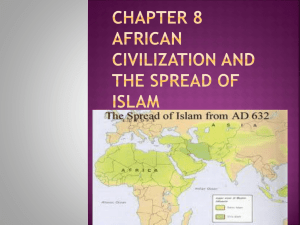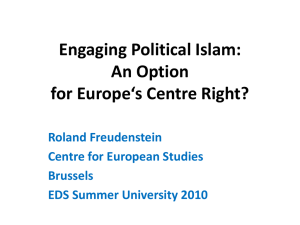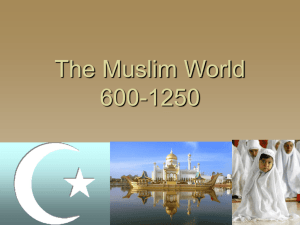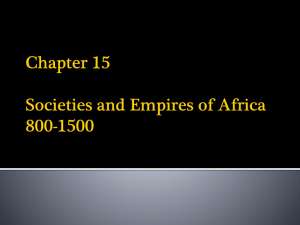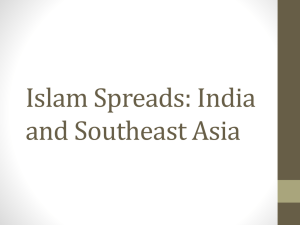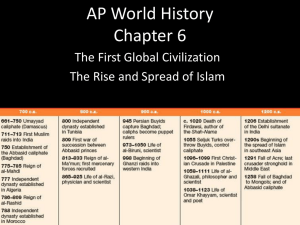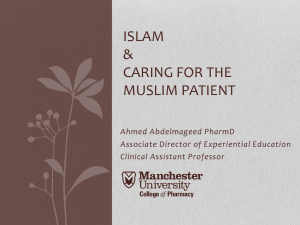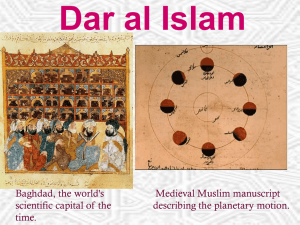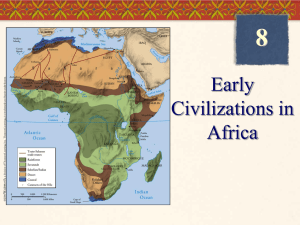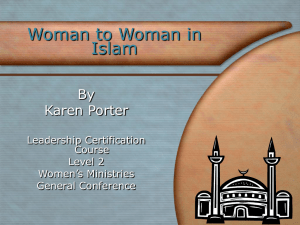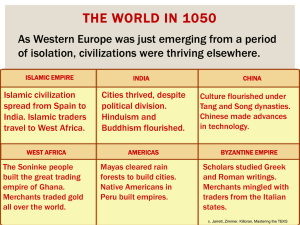African States and Islam PPT - Phillipsburg School District
advertisement
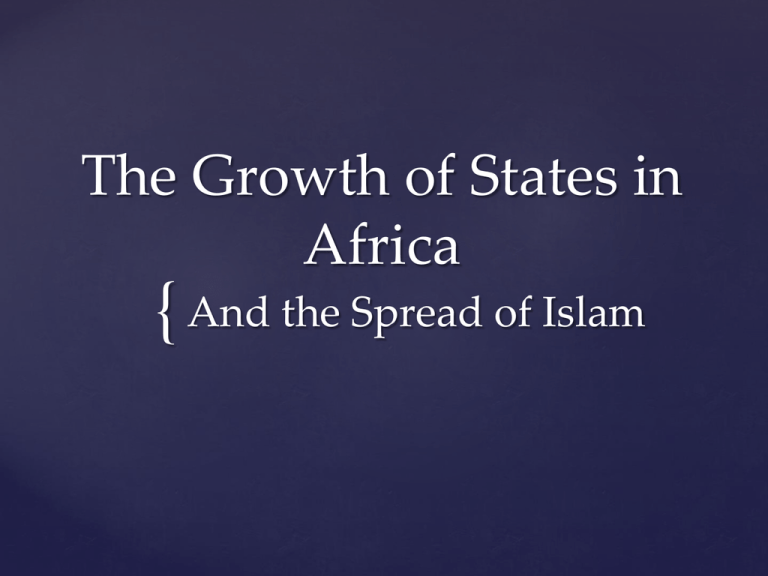
The Growth of States in
Africa
{ And the Spread of Islam
Regional states and large kingdoms became increasingly prominent after 1000
CE as Bantu and other African ppls responded to population pressures and
military challenges facing their societies.
Increasing population growth strained resources but no new land was
available so this led to conflict
The organization of military forces encouraged the development of more
formal structures of gov’t
Districts fell under the leadership of powerful chiefs who overrode kinship
networks and imposed their own authority on the territory
Some conquered neighbors and consolidated lands into small kingdoms
These developments occurred esp. in several regions of sub-Saharan Africa
after 1000 CE.
But stateless societies continued to exist in all parts of Africa
Overview
©2004 Wadsworth, a division of Thomson Learning, Inc. Thomson Learning™ is a trademark used herein under
license.
The Emergence of States in Africa
Both Ife and Benin were kingdoms that arose in the
forested regions of West Africa.
City-States in which the court and urban residents
controlled the surrounding countryside through family
relationships and political alliances.
Also produced magnificent sculptures
Chiefdoms
Central African kingdom
After 1000 small states developed. By 1200 conflict b/t them had
resulted in the organization of larger regional principalities that
could resist political and military pressures.
One of the more prosperous of these states was the kingdom of
Kongo which participated actively in trade networks involving
copper, cloth, and nzimbu shells from the Atlantic Ocean.
It had a central gov’t which included the king and officials who
oversaw military, judicial and financial affairs. Beneath the central
gov’t were 6 provinces administered by governors who supervised
several districts administered by subordinate officials. Within the
districts villages ruled by chiefs provided local gov’t.
It wasn’t the only kingdom but it was the most tightly centralized
of the early Bantu kingdoms
The authority of the king and central gov’t was undermined by
Port slave traders.
Kongo
Long-distance trade helped spur on the development of kingdoms in east and
central Africa. Trade and its wealth helped establish large and powerful
kingdoms
Best known is Zimbabwe—the dwelling of a chief
Early 13th century interior peoples built a magnificent stone complex known as
Great Zimbabwe near Nyanda. Stone walls 16 ft thick, 32 ft tall, it was a city of
stone towers, palaces, & public buildings that served as the capital of a huge
kingdom.
18,000 ppl may have lived in its vicinity and it stretched from Sofala deep into the
interior of south-central Africa.
Kings residing in the Great Zimbabwe controlled and taxed the trade betwn the
interior and coastal regions, organized the flow of gold, ivory, and slaves and
local products from the sources of supply to the coast. They made alliances with
local leaders and made money from the transactions
The trans-Saharan trade encouraged building of states and empires in West
Africa, Indian Ocean trade financed the organization of city-states along coast and
large kingdoms in the interior region of east and central Africa.
Zimbabwe
Christianity reached N. Africa in 1st Cen. CE.
Alexandria became one of most prominent centers of early Christianity
Mid-4th cen. Christianity estab. A foothold in Axum
st
1 converts were probably local merchants who traded with Christians who came to
port of Adulis on Red Sea.
King of Axum converted around the time of Constantine
Late 7th cen. Axum fell into decline
In 12th cen. New dynasty tried to centralize and promote Christianity to unify the land.
12th cen. Ethiopian king ordered the carving of 11 massive churches out of solid rock
Ethiopian Christ. Was cut off from other Christians-so it reflects the interests of its
African followers
They believe in a large host of evil spirtis populating the world and they carry
amulets for protection
Rock churches link to rock shrines that were important in Ethiopian religion
Not til 16th cen. That Ethipian Chris. Reestab. Relations with other Christians.
The Kingdom of Ethiopia: A Christian Island in a Muslim Sea
Axum began to decline
Shift in trade routes and overexploited agriculture
Muslim trading states on the African coast of the Red Sea transformed Axum into an
isolated agricultural society
Source of ivory, resins, and slaves
Attacked by Muslim state of Adal in early 14th century
Christianity in North Africa
Kingdom of Axum [300-700]
Christian Church, Lalibela [Ethiopia]
Christian Church, Lalibela
[Ethiopia]
Coptic Christian Priest
Islam initially spread into North Africa under the first caliphs
(bypassing the already Christian Ethiopia), spread south across
the Sahara into West Africa by Berber tribes.
The first West African converts were rulers of kingdoms
(including Mali) which saw Islam as a valuable tool with
which to increase their authority. It was also useful to
impose monotheistic belief on a diverse, polytheistic
population.
Conversion by the masses was more gradual and rarely
eliminated all Animist rituals/beliefs.
West African kingdoms were increasingly connected to the
outside world through trade and the Hajj.
The Spread of Islam
African Religious Beliefs before Islam
Common beliefs
Single creator god
Sometimes accompanied by a pantheon of
lesser gods
Most believed in an afterlife in which ancestral souls floated in the
atmosphere through eternity
Closely connected to importance of ancestors and lineage
Rituals very important
Challenged by Islam but not always replaced;
synthesized and supplemented
Ex. Africans still took protective measures against evil spirits and
participated in rituals to please nature dieties and spirits of departed
ancestors.
The Coming of Islam
Islam Spreads to North Africa and
Spain
North Africa
Arab forces seized the Nile delta of Egypt in 641
New capital at Cairo
Arabs were welcomed due to high taxes and periodic
persecution of Coptic Christians by Byzantines
Arabs seized Carthage in 690, called Al Maghrib
Berbers resisted for many years
.From the mid-seventh century, Muslim armies pushed westward
from Egypt across the region called Ifriqiya by the Romans and the
Maghrib (the West) by the Arabs.
By 711 they crossed into Spain. Conversion was rapid, but initial
unity was soon lost as North Africa divided into competing Muslim
states. The indigenous Berbers were an integral part of the process.
Would have spread into Europe but were stopped in 732 by Charles
Martel in Poitiers at the Battle of Tours.
In the eleventh century, reforming Muslim Berbers, the Almoravids
of the western Sahara, controlled lands extending from the southern
savanna and into Spain. They wanted to purify Islam.
In the twelfth century another group, the Almohadis, succeeded
them.
Abbasid caliphate lasted 750- 1258
But as it declined the caliphs failed to keep control of all
the territory
Independent Muslim states sprang up and local leaders
dominated many smaller regions
An example was the Fatimid dynasty, named after
Muhammad’s daughter Fatima
Began in North Africa and spread to western Arabia and
Syria
Fatimid Dynasty
Although they were politically divided, the Abbasid Empire and
smaller powers stayed unified through religion, language, trade, and
the economy
An important part of the Muslim world was al-Andalus Spain. A
mixture of Muslims, Christians and Jews created a cosmopolitan
atmosphere in its capital city of Cordoba
City attracted poets, philosophers, scientists and doctors
City became the center of Muslim culture with 70 libraries, 700
mosques and 27 free schools
Period of achievements in the arts and sciences followed
By 10th century it was a place of harmony & tolerance b/t the various
religious groups
But the golden age was short-lived. By 11th & 12th cen. conflict and
intolerance and prejudice increased as the Christian reconquest gained
ground. (ended in 1492)--The Nasrids were the last Islamic dynasty in
the West (Spain)
Significance of Muslim Spain was its role in making the heritage of
Islamic learning available to Christian Europe and played a role in the
making of a new European civilization in the 13th cen and later.
Cordoba
Great Mosque Interior
Cordoba
Nasrid Palace at the Alhambra
Court of Lions,
Alhambra palace
Granada
mid 14th century
Islam caused Arab peoples to unite
through their faith
This cultural growth spawned growth of a
new artistic culture
Works of monumental sculpture resulted,
as well as book arts (calligraphy,
illustration)
The Religious Culture of Islam
Mosque: from Arabic masjid, place for
bowing down
Arcades: Rows of arches
Minaret: Square tower
Mihrab: Empty niche
Qibla: Wall, indicating the direction of Mecca
Iwan: An entry to a royal reception hall
Muqarnas: A characteristic Islamic
architectural ornament, niche-like “scoops” in
entryways, etc.
Islamic Architectural Vocabulary
Islamic scholars typically memorize the Qur’an
Writing out the Qur’an is considered an act of prayer
Because of this, calligraphy became the most highly
regarded art in Islamic lands - calligraphers were honored
much like painters and sculptors in Europe
The Qur’an was never illustrated with images of animate
beings - the reason for the existing geometric patterns,
stylized organic forms
Baghdad was a major center for book production and
scholarship
Book Arts - The Qur’an
Page, copy of Qur’an
Ahmad al-Suhrawardi,
calligrapher
Baghdad, 1307
20 x 14”
ink, color & gold on paper
…Princess in the
Black Pavilion
Hatifi’s Haft Manzar
Bukhara, 1538
Islam in Africa
3 important coasts of contact: Atlantic, Indian
Ocean, and savanna
Sahel-area between the western forests and the
northern desert. Here is where the merchants
came to trade. Camels brought from Asia couldn’t
survive the humid regions of the forests. So the
grasslands is where merchants came to trade.
Therefore, cities were established. In the 3rd
century Ghana developed. By the 10th century it
was in its hayday! Rulers had also converted to
Islam
However, they declined due to attacks by the
Almoravid armies 1076
Mali would replace it
There were many kingdoms active in Africa
Sudanic states often had a patriarch or council
of elders of a family that ruled
Terriortial core of similar peoples with
conquered extension that paid taxes or tribute
Ghana, Mali, and Songhay powerful examples
Rules considered scared
Islam accepted and people mixed Islam with
their culture
Sudanic States
Mali and Sundiata
Malinke people broke away from Ghana in the
13th century to create Mali
Islamic
Agricultural and merchant state
Juula-Malinke merchants
Malinke expansion under Sundiata (Sunjata). He
became the Mansa or emperor
Divided the kingdom into social order, created
political institutions, and stationed garrisons.
Made trade safe.
Sundiata died in 1260
Mansa Kankan Musa –later successor (hajj 1324)
Cities and Villages in Sudan
Mix of Islamic and Sudanese
Examples: Jenne and Timbuktu
Town were commercial with specialists and
foreign residents. Scholars and theologians
attracted.
Strong military to protect merchants
Libraries and universities developed. Books trade
very lucrative here!
For most people life was centered around village
life and agriculture. 80% of villagers lived by
farming. Farms were small due to lack of tools. A
large farm was only about 10 acres. Polygamy
practiced here…why?
Rice, millet, sorghum, wheat, fruits, and veggies
Sorghum-grain or livestock food
Millet
Wheat
Songhay Kingdom
Formed as Mali was declining within part of
Mali. People of Songhay were from the middle
area in the Niger Valley. Made up of farmers,
herders, and fisherman
By the 7th century started to form a independent
territory
By 1010 capital established at Gao along the
Niger River. Rulers were Muslims.
By 1370’s Songhay reestablished itself as an
independent kingdom again from Mali
Under Sunni Ali (1464-1492) Songhay became an
empire!
Songhay
Sunni Ali was a great military commander who extended
the empire and took over Jenne and Timbuktu.
Set up provincial administrations to deliver his rule
Muslim scholars not his biggest fans. They questioned his
authority! Ruler who succeeded him took on the military
title askia.
Muhammad the Great extended the Songhay boundaries
so that by the mid-16th century Songhay dominated the
Sudan!
Overall problem between Muslim scholars and African
converts b/c they mixed Islam with their local pagan
beliefs. Men and women mixed freely and women went
unveiled.
Remained the dominate power until 1591 when a Muslim
army from Morocco attacked. They had muskets!
Rise of the Hausa states in N. Nigeria
Sudanic States: politics and social life
State structure allowed for many diverse people to coexist
Universal faith-Islam which also provided common laws
Rulers-emir or caliph (to reinforce authority) Mixed pagan
and Muslim beliefs
Women enjoyed more freedom, no veils, free in markets,
some groups traced linage through mother (matrilineal).
Slavery: existed before Muslims came, but they developed
it on a larger scale. Muslims viewed slavery as a stage in
conversion. Slaves: domestic servants, soldiers,
administrators, eunuchs, concubines. Focus on child and
female slaves. Trade caravans transported many slaves
across the Sahara to ports in the Indian Ocean. Trade
extended for over 700 years. Think back to Nubia!
Swahili Coast-East Africa
Islam spread along Eastern coast and merchant activity
spread and Muslim ports where established along the
Indian Ocean
Bantu-speaking people migrated here along with refugees
from Oman
By 13th century African trading ports developed along the
coast. These towns shared common Bantu-based and
Arabic-influenced Swahili (meaning coastal) language and
other traits.
Ruled by separate Muslim ruling families
Trade in ivory, gold, slaves, iron, and exotic animals for
silks and porcelain
Kilwa most powerful of these port cities
Some Chinese sent good directly to these ports. As late as
1417 and 1431 large state sponsored expeditions sailing
from China to Africa occurred.
Swahili, Land of Zenj
Port cities developed into city-states with their own local
governments. Rulers interested in controlling slave trade
and not making territorial conquests.
Palace in Kilwa
Cultural hybrid
-Between Arabic
and African
Swahili –bantu and
Arabic words
-Many in-land
Africans not Muslim
-1500 Portuguese
